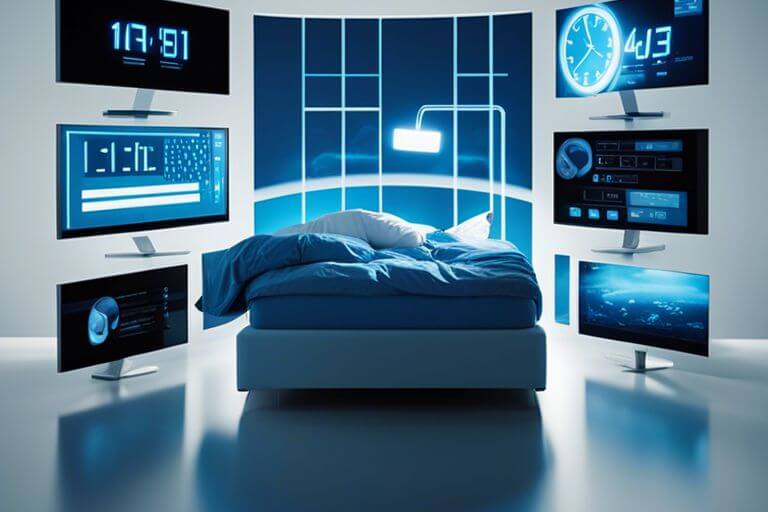Blue Light and Sleepless Nights – Understanding Screen Time’s Impact
Sleepless Nights are a common complaint in our modern, technology-driven society.
With the rise of smartphones, tablets, and computers, many of us find ourselves staring at screens well into the evening hours.
However, what most people don’t realize is that the blue light emitted by these devices can have a significant impact on our sleep quality.
Studies have shown that exposure to blue light in the evening can disrupt our circadian rhythm, making it harder to fall asleep and stay asleep.
In this blog post, we will explore the effects of blue light on sleep and provide tips on how to minimize its impact for a better night’s rest.
Understanding Blue Light
What Is Blue Light?
One of the visible light spectrums, blue light, is a high-energy, short-wavelength light that is emitted by the sun as well as digital screens and electronic devices.
Exposure to this type of light has been the subject of much discussion due to its potential impact on our health and sleep patterns.
Natural vs. Artificial Sources
Sources of blue light can be categorized into two main groups – natural and artificial.
Natural sources include the sun, which is the primary source of blue light.
On the other hand, artificial sources include digital screens like smartphones, tablets, computers, and even LED lighting.
Both types of sources can emit blue light, but the intensity and duration of exposure can vary significantly.
The Science of Sleep
Circadian Rhythms Explained
You are probably familiar with the concept of circadian rhythms, which are the internal clock that regulates our sleep-wake cycle.
This biological process influences the timing of when we feel sleepy and when we feel alert, and it is controlled by the body’s exposure to light and darkness.
How Light Influences Sleep-Wake Cycles
The impact of light on our sleep-wake cycles is profound.
Exposure to blue light, emitted by screens and electronic devices, can disrupt the production of the sleep hormone melatonin, which makes it harder to fall asleep.
Additionally, exposure to light at night can throw off our circadian rhythms and lead to sleep disturbances.
Sleep is vital for overall health and well-being. Inadequate or poor-quality sleep can have serious consequences, including increased risk of chronic conditions such as obesity, diabetes, and heart disease.
By understanding the science behind sleep and the impact of light on our sleep-wake cycles, we can take steps to improve our sleep hygiene and overall health.
Screen Time and Its Consequences
The Ubiquity of Screens in Daily Life
Ubiquity – Screens have become an inseparable part of our daily lives, from smartphones and tablets to computers and televisions.
We use screens for work, entertainment, communication, and even relaxation.
The ease of access to screens has led to a significant increase in screen time for people of all ages.
Linking Screen Time with Sleep Disruptions
Time – It is well-established that excessive screen time can have detrimental effects on our sleep patterns.
The blue light emitted by screens can suppress the production of melatonin, the hormone that regulates our sleep-wake cycle. This makes it harder to fall asleep and can disrupt the quality of our sleep.
Additionally, research has shown that the content we engage with on screens, such as social media or stimulating videos, can also contribute to sleep disturbances.
The constant stimulation from screens can keep our minds active and make it difficult to unwind before bedtime, further exacerbating sleep issues.
Mitigating the Effects of Blue Light
Strategies for Reducing Exposure
On a daily basis, individuals can take simple yet effective steps to reduce their exposure to blue light.
One strategy is to limit screen time before bedtime, as exposure to screens close to sleep can disrupt the body’s natural circadian rhythm.
Another approach is to use blue light filters or glasses that can help block out harmful blue light emitted from screens.
Technological Solutions and Tools
Any modern electronic device user concerned about blue light exposure can benefit from technological solutions and tools available in the market.
These include apps and software that adjust the color temperature of screens, reducing the amount of blue light emitted.
Additionally, some devices come with built-in blue light filter settings that can be activated to protect the eyes from prolonged exposure.
Plus, it is necessary for users to actively utilize these tools and settings, as consistently high levels of blue light exposure can lead to sleep disturbances, eye strain, and potentially more serious health issues over time.
Conclusion
Ultimately, it is crucial to recognize the impact of blue light from screens on our sleep patterns.
Excessive screen time before bedtime can disrupt our natural circadian rhythm and lead to sleep disturbances.
By being mindful of our screen usage and implementing strategies to reduce exposure to blue light, we can improve the quality of our sleep and overall well-being.
Understanding the effects of blue light on our sleep is the first step towards creating healthier habits around screen time.

